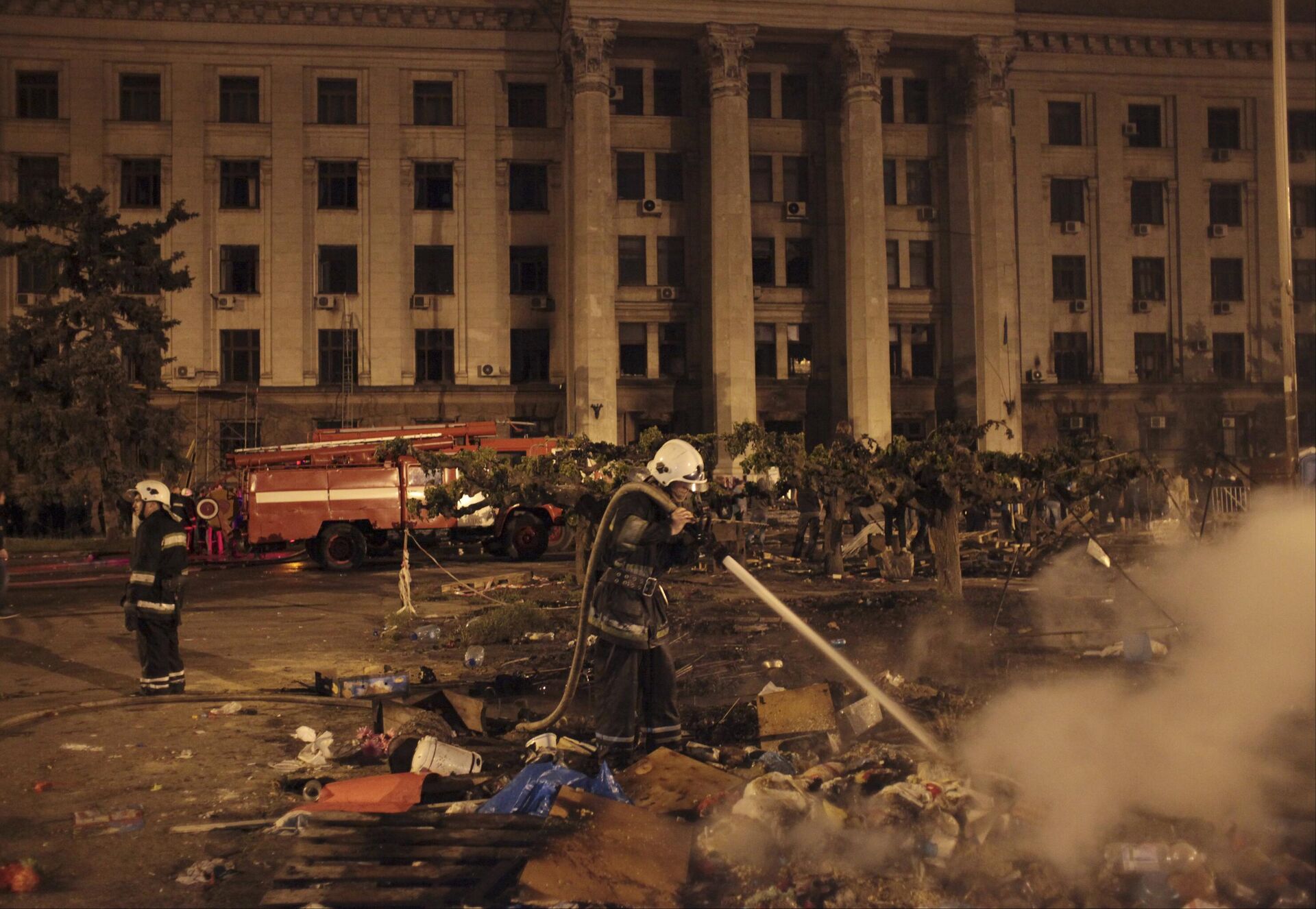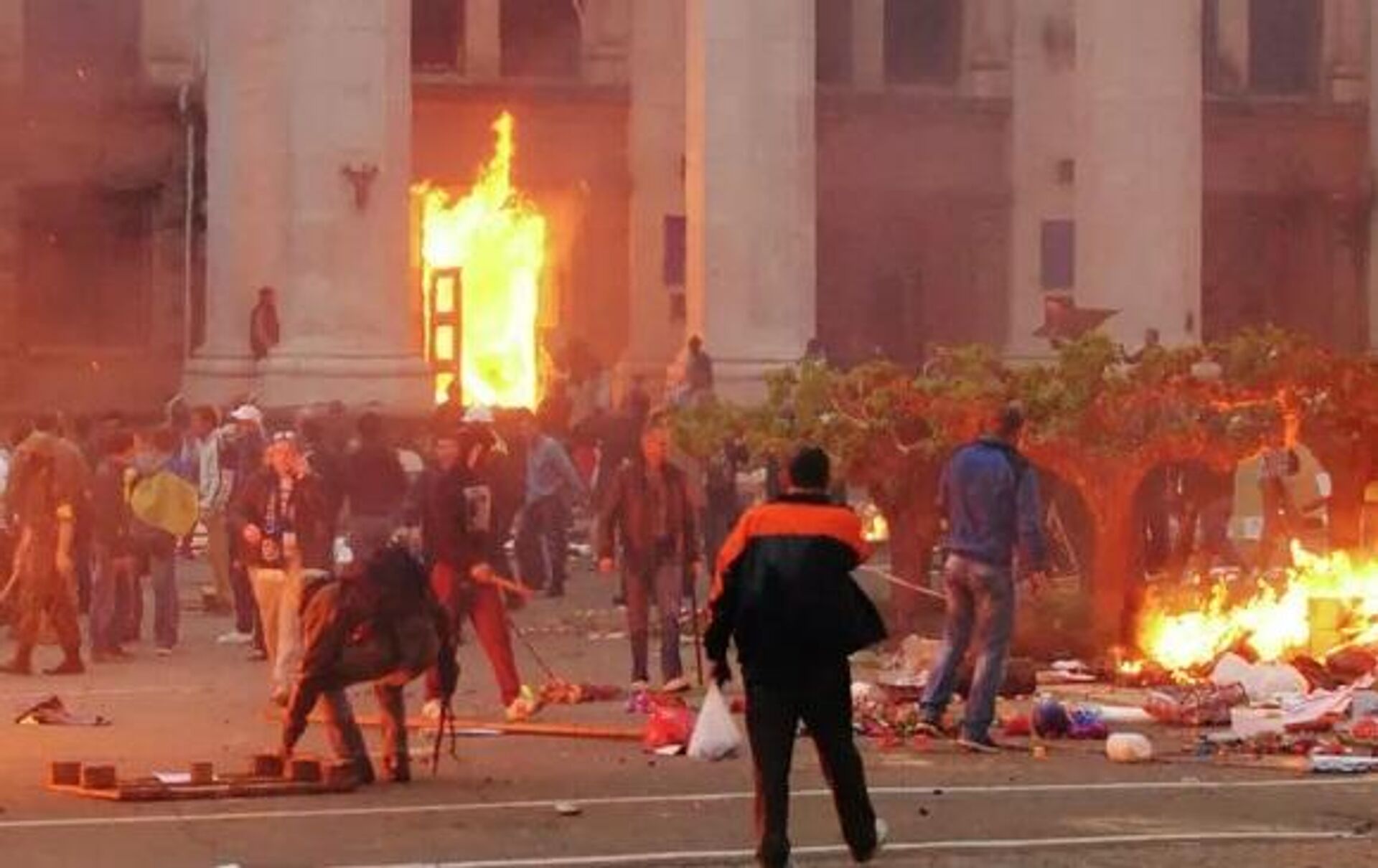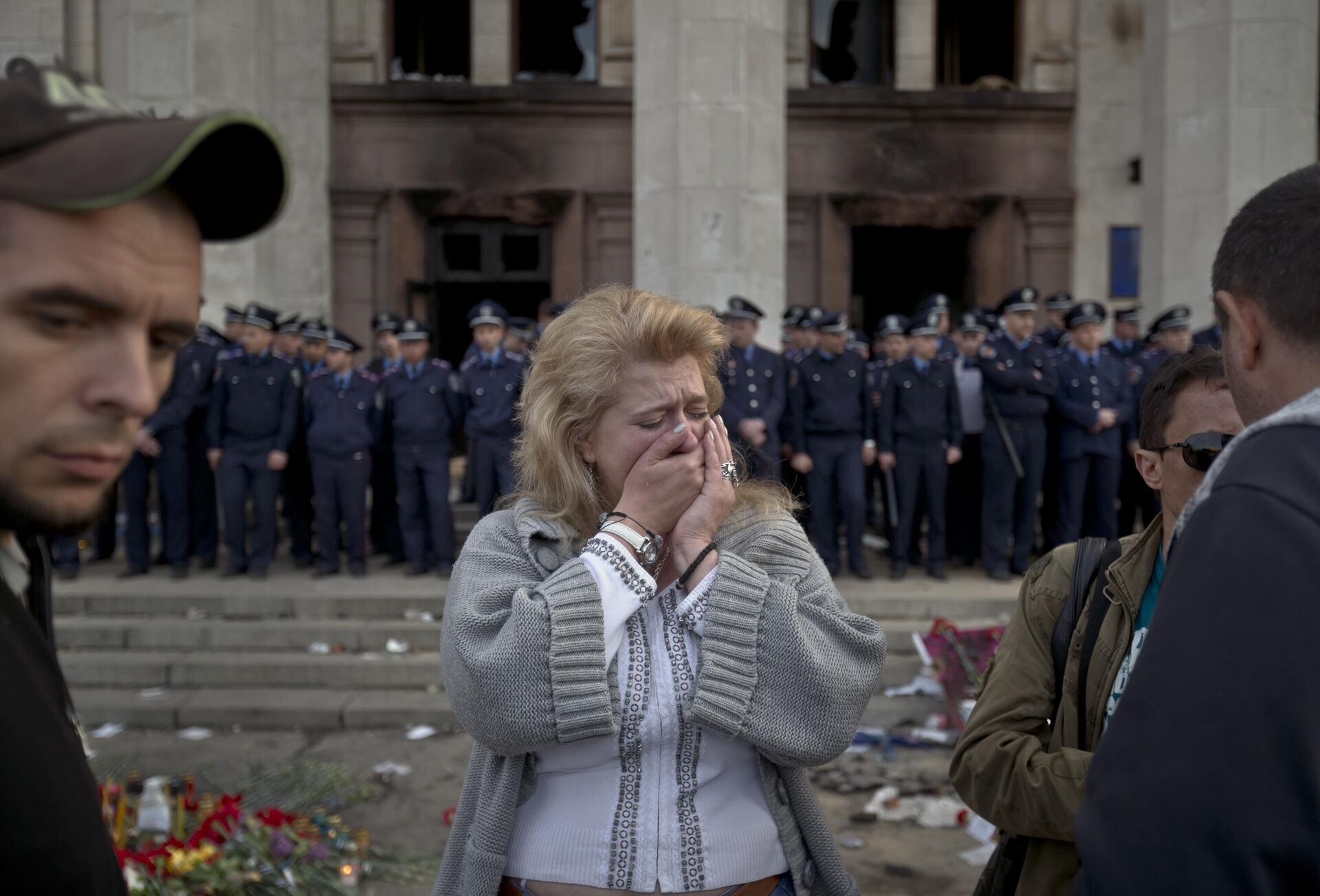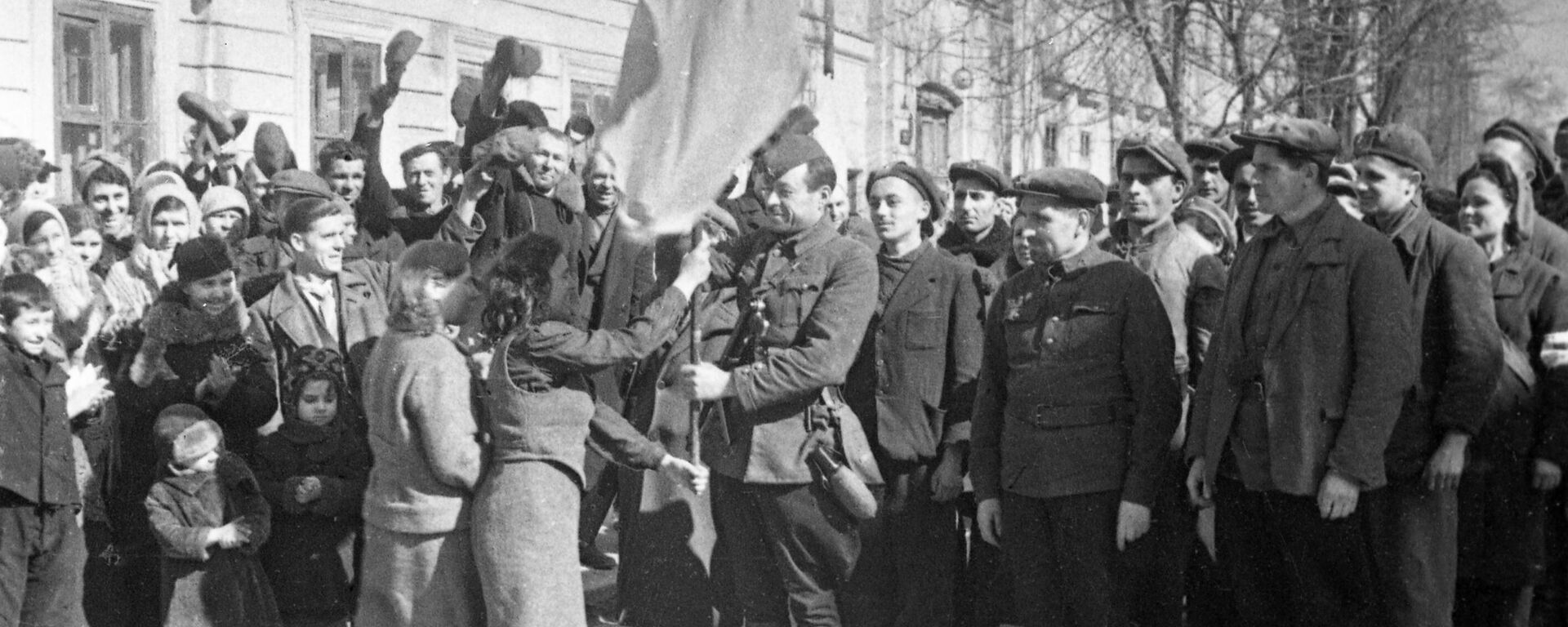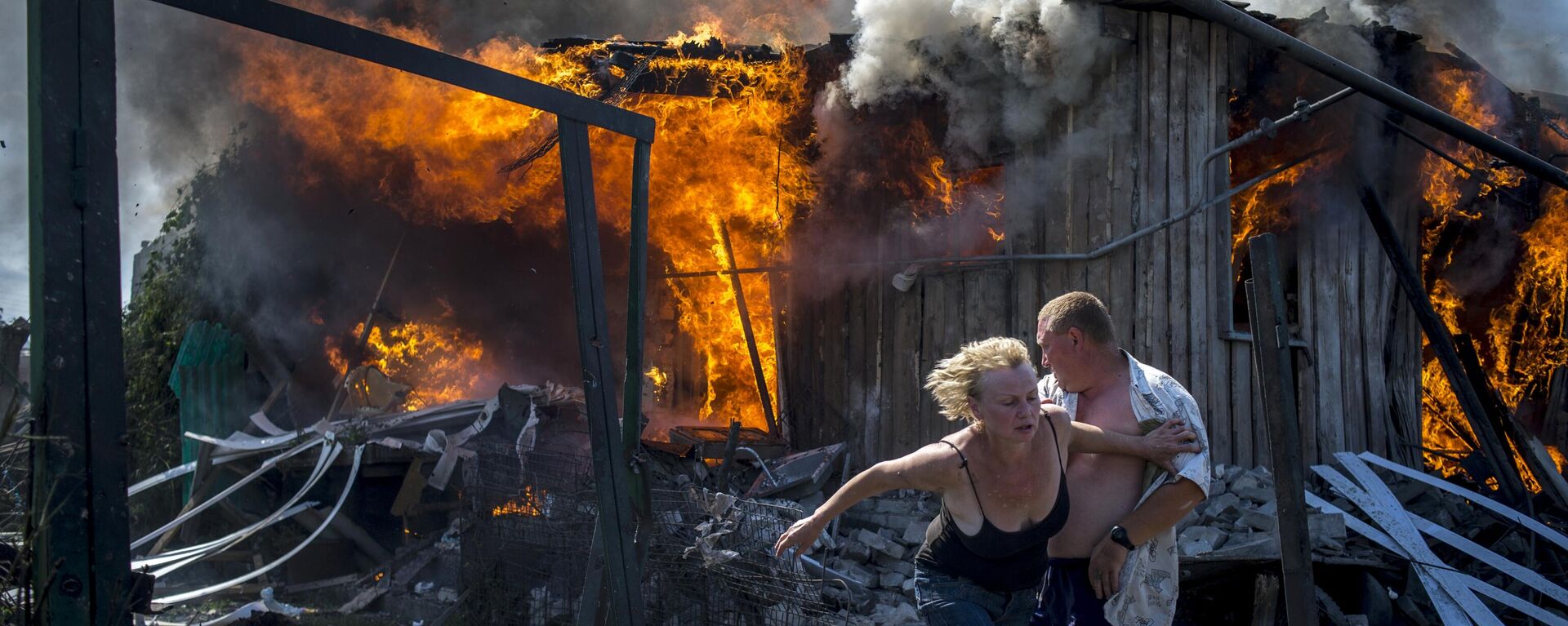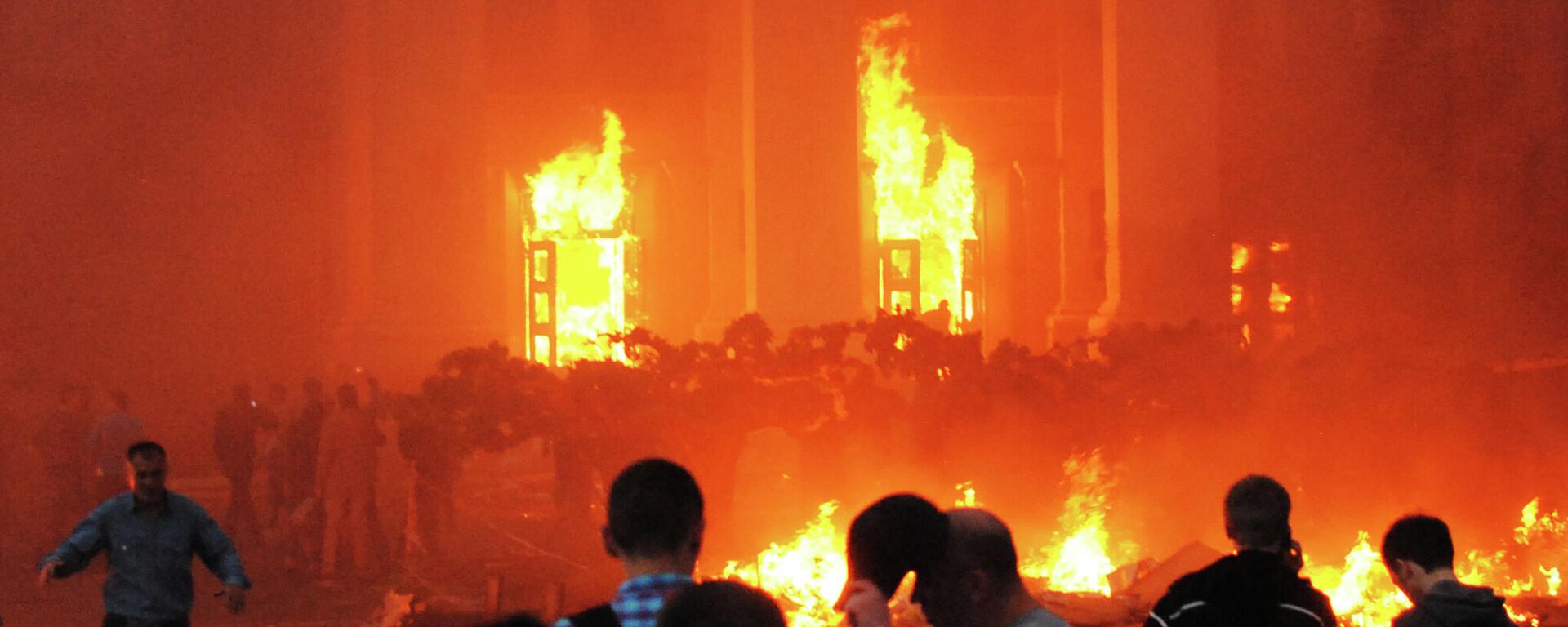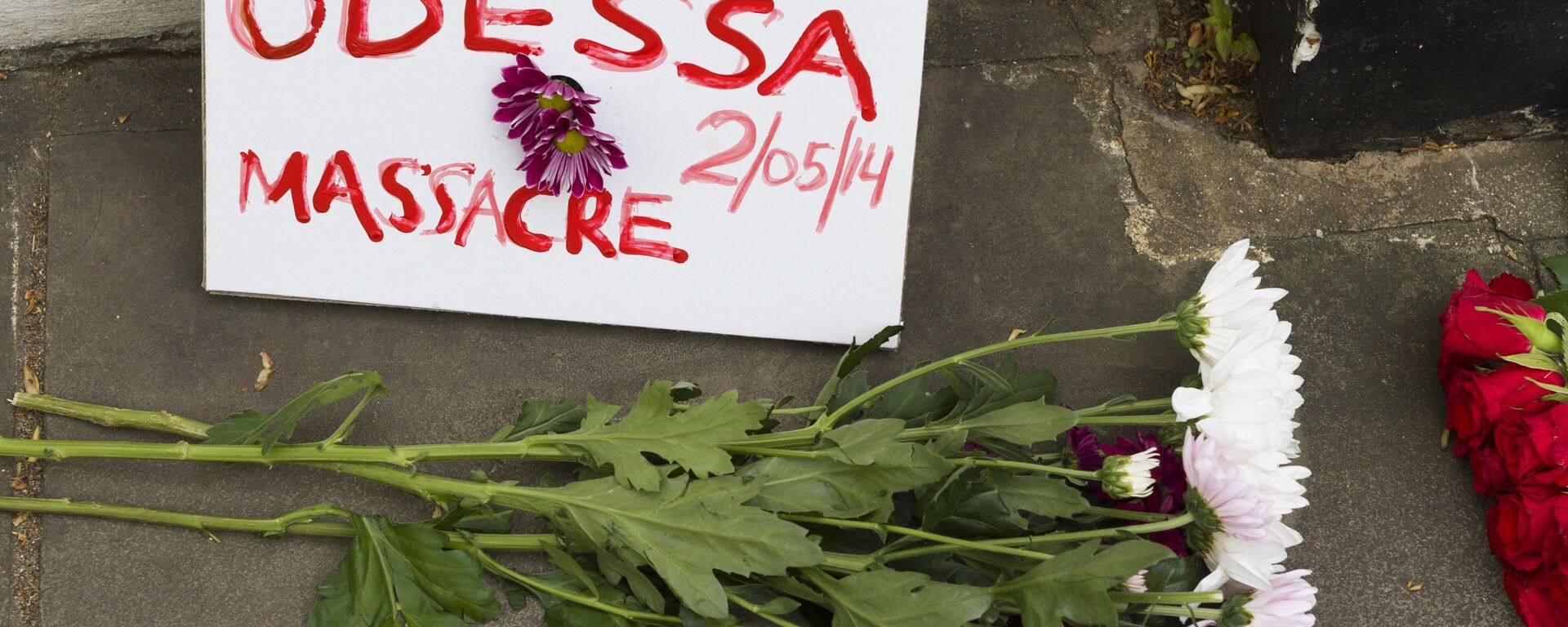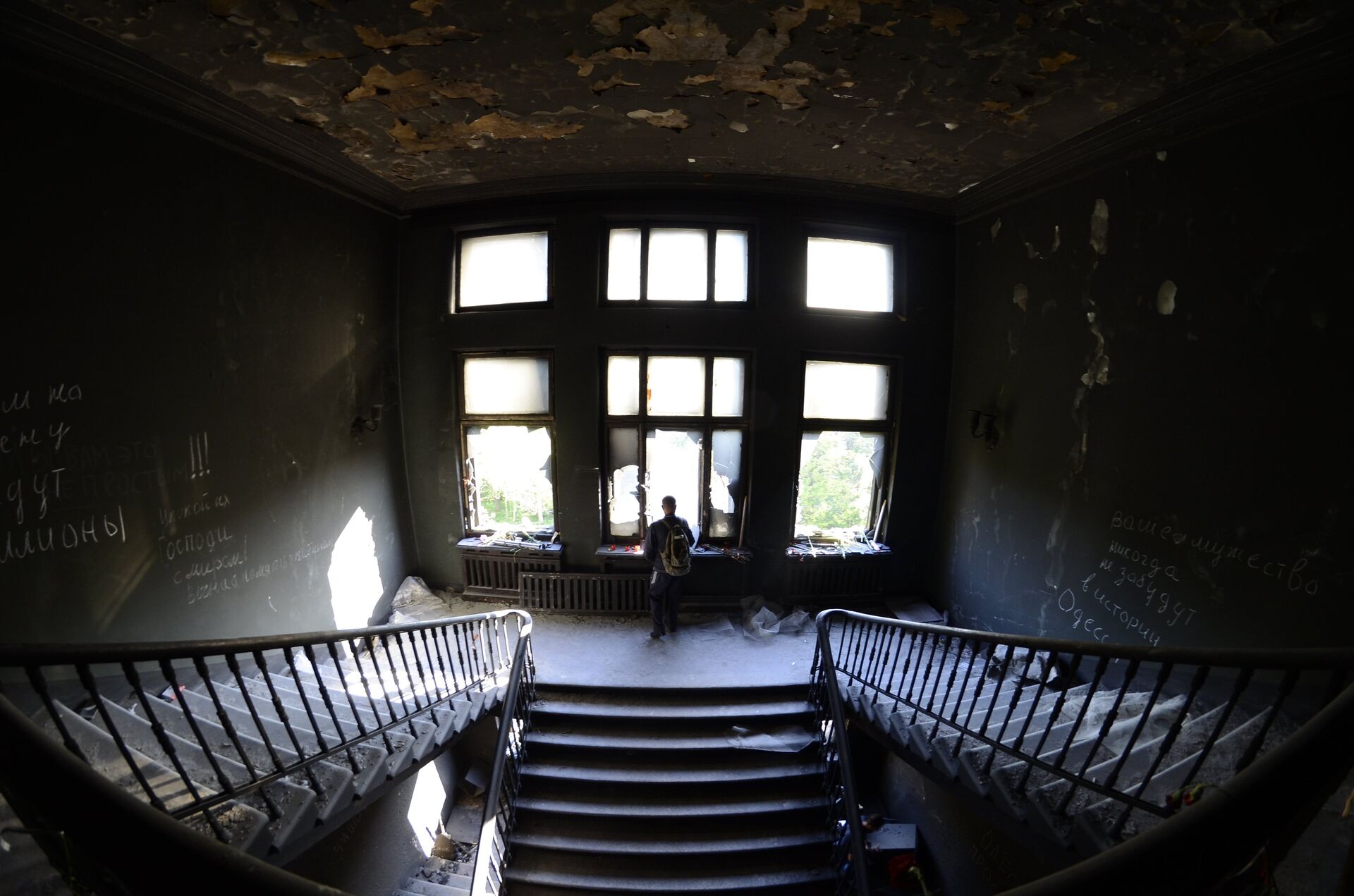https://sputnikglobe.com/20240502/odessa-massacre-ten-years-on-how-radicals-drowned-city-in-blood-to-subdue-ukraine-1118193803.html
Odessa Massacre Ten Years On: How Radicals Drowned City in Blood to Subdue Ukraine
Odessa Massacre Ten Years On: How Radicals Drowned City in Blood to Subdue Ukraine
Sputnik International
Thursday marks the 10th anniversary of the May 2, 2014 Odessa Trade Unions Building massacre, in which 48 anti-Maidan activists were burned alive by neo-Nazi thugs
2024-05-02T06:00+0000
2024-05-02T06:00+0000
2024-05-02T06:00+0000
analysis
odessa
ukraine
kiev
ukrainian security service (sbu)
european union (eu)
viktor yanukovych
https://cdn1.img.sputnikglobe.com/img/07e7/05/02/1110026799_0:220:2416:1578_1920x0_80_0_0_5968d73e03145120cf207908061344c5.jpg
The warm weather of the spring of 2014 was accompanied by the winds of revolutionary fervor across southeastern Ukraine, with activists from across Kharkov, the Donbass, Zaporozhye, Dnepropetrovsk, Kherson, Nikolayev and Odessa rising up in opposition to the Euromaidan coup in Kiev that had taken place in February.The US and EU-sponsored insurrection in the Ukrainian capital, which culminated in the ouster of democratically elected government of President Viktor Yanukovych and his replacement by radical pro-US and ultra-nationalist forces seeking to scupper relations with Russia in favor of closer ties with the West, was met with anger by many residents in Ukraine’s southeast. Holding dear the centuries of common historical, cultural, linguistic, family, economic and other bonds with Russia, residents of southeastern regions favored Ukraine’s entry into the Eurasian Union, and expressed opposition to the pro-EU, pro-NATO course of the new authorities in Kiev.Odessa, Ukraine’s third-largest city after Kiev and Kharkov, was a crown jewel in the Russian Empire and the Soviet Union, bearing witness to almost all of the dramatic events of the 20th century. Odessa’s residents were involved in the 1905 Russian Revolution and the Russian Civil War of 1917-1922. The city became a key center of resistance to the Nazis during the opening months of the Great Patriotic War, heroically holding out against numerically superior Axis forces for 73 days until mid-October 1941, and liberated in April 1944 after over two-and-a-half years of grueling occupation.When the Euromaidan protests began in November 2013, and as pro-Maidan activists had only just established their first encampments in the center of Kiev to protest the Yanukovych government’s rejection of a European association deal with the EU, Odessa became among the first cities in Ukraine’s southeast where opposition to the Maidan was organized.Between November 2013 to January 2014, supporters and opponents of the Euromaidan organized competing rallies. The former gathered before the Duc de Richelieu Monument, at the top of Odessa’s Potemkin Stairs, while the latter set up a presence at Kulikovo Field (formerly October Revolution Square) – a garden square in the historical center of the city containing the House of Trade Unions Building.The opposing movements’ demands were straightforward. Euromaidan supporters joined with their compatriots in the capital calling for Yanukovych’s ouster and closer ties with Europe. Opponents called on the authorities to restore order, demanded the preservation of ties with Russia, and marked vocal opposition to the rise of radical nationalist sentiments which would make up the aggressive backbone of the pro-Maidan camp.The situation in Odessa escalated in sync with events in Kiev, with pro-Maidan activists clashing with police and protesting in front of administrative buildings amid a wave of government building seizures sweeping western Ukraine. Pro-Maidan hooligans from the ‘AutoMaidan’ and ‘Odessa Euromaidan Self-Defense’ volunteer groupings also began clashing with volunteer Odessa ‘People’s Squads’ opposed to the Maidan.The situation in Odessa escalated through March of 2014, after Crimea’s residents voted in a referendum to break off from Ukraine and rejoin Russia, and in April, amid a series of protests in Donetsk, Lugansk and Kharkov which saw anti-Maidan activists capture administrative buildings and join in calls for federalization. The latter were met with punitive military and intelligence operations by Ukraine’s security services and army, with hundreds of activists in Kharkov rounded up, beaten, disappeared, jailed or forced to flee their homes, while the residents of the Donbass formed people’s militias and proclaimed people’s republics to resist Kiev’s brutal ‘anti-terrorist’ operation.May 2 MassacreSputnik has extensively documented the events of May 2, 2014 over the past ten years, speaking with eyewitnesses and journalists, and keeping tabs on Ukrainian authorities’ efforts to hunt down and arrest the victims, rather than the perpetrators, of the extreme violence that took place that day.On the afternoon of May 2, as many as 2,000 pro-Maidan activists, buoyed by FC Chornomorets Odessa and FC Metalist Kharkov football ultras, marched toward the anti-Maidan encampment at Kulikovo Field, which Odessa’s new authorities had demanded be taken down ahead of the Victory Day festivities. Fistfights and scuffles between men armed with sticks, bats, makeshift shields, rocks, airguns and a sprinkling of firearms quickly broke out. Police did little to stop the violence, sparking claims from Kulikovo Field’s defenders that the security forces were in collusion with the nationalists and ultras.The violence soon took a deadly turn, with the pro-Maidan thugs and football fanatics, outnumbering anti-Maidan protesters 10-to-1, managing to heard dozens of ‘People’s Squad’ members and civilians into the House of Trade Unions Building, setting it ablaze with petrol bombs. Trapped from all sides and offered no chance to escape, at least 42 anti-Maidan activists were killed, asphyxiated by smoke, burned alive, murdered inside the building or jumping out of windows and finished off by ultras on the ground. Another six people were killed by gunfire, with over 200 people injured.Ten years on, despite protests from the European Court of Human Rights and the Office of the United Nations High Commissioner for Human Rights, the perpetrators of the Odessa Trade Unions Building Massacre remain free, with authorities, law enforcement and courts showing through inaction that they are uninterested in prosecuting the case.Terrifying Ukraine Into SubmissionThe Odessa Massacre was a premeditated crime designed to put down anti-Maidan protests not only in the city, but across Ukraine, says Vasily Polishchuk, an eyewitness to the events and a former lawmaker in the Odessa City Council who has devoted ten years of his life to investigating the incident.A veteran of the Soviet War in Afghanistan and former lawmaker from Ukraine’s Communist Party, Polishchuk was forced to leave his home city of Odessa in the wake of the events of May 2, 2014, facing persecution and physical violence targeting his son and assistance amid his investigation into the Trade Unions Building fire.Polishchuk says the events of that day claimed the lives of not 48 people, but at least 51, and likely more.Odessa’s Anti-Maidan activists were “99.9 percent” locals, Polishchuk recalled, debunking claims by Ukrainian authorities and Western media that the protests in the city had been organized by Russian nationals or even Russia’s intelligence services.Operation Prepared Well in AdvanceAmong the pro-Maidan forces, the former lawmaker estimates that as few as 10 percent were locals, with the majority made up of residents of other cities and regions, brought into the rebellious city to enforce the new order in the wake of the coup in Kiev.Polishchuk is convinced that the violent operation to disperse the anti-Maidan forces at Kulikovo Field was prepared well in advance – as much as a month and a half beforehand. Having come to power in Kiev, Ukraine’s new authorities began to send armed and trained thugs south to tame anti-Maidan sentiments in the south and southeast, particularly in Odessa and Nikolayev, where serious protest movements had sprouted in opposition to the new government.These forces were well-organized, the investigator emphasized, pointing out that as many as five checkpoints were set up around Odessa manned by Euromaidan activists, who took it upon themselves to inspect vehicles coming into and out of the city, and ignored the police and even government officials’ orders that the posts be dismantled.The Chernomorets-Metalist football match became a perfect chance for pro-Maidan hooligans, Polishchuk said, with the match accompanied by the arrival of hundreds of additional radicals into the city.Polishchuk speculates the direct involvement of the Ukrainian Security Service in putting down the anti-Maidan unrest, pointing to bragging by the agency in the Odessa Massacre’s aftermath that operations carried out in Kharkov, Nikolayev and Odessa to dismantle anti-Maidan forces had been successful and that “opponents were defeated.”Polishchuk also pointed out that on May 2, hours before the Kulikovo Field clashes, Ukrainian Deputy Prosecutor General Mykola Banchuk had arrived in Odessa, gathering members of the security forces and officials from the regional prosecutor’s office on Pushkinskaya Street at 12 noon. He ordered that mobile phones be turned off, with the meeting dedicated to the ‘fight against separatism’. For what reason? So that the police, who are supposed to ensure the protection of public order, did not interfere with the conduct of the ‘special mission’. He provided them with an alibi.”‘Horror Ensues’The former lawmaker, who was at Kulikovo Field and witnessed events firsthand as they developed, recalled his desperate efforts to get the anti-Maidan activists to leave the area after realizing the balance of forces.“The ratio was about 1,500-2,000 Maidan supporters against 150-200 anti-Maidan activists. It was immediately clear to me how it would end. I told them ‘get out of here, leave.’ ‘No, we won’t leave, we won’t leave’, they answered. The Euromaidan forces had plenty of weapons. Naturally, horror ensued,” Polishchuk recalled.Polishchuk is “100 percent” certain on the names of at least 51 people were killed, and about 230 injured. “Only an honest investigation will reveal the exact number,” he said.Unfortunately, the former lawmaker noted, Ukraine’s authorities aren’t interested in such an investigation, because carrying it out would only “incriminate themselves.”An honest investigation never stood a chance, Polishchuk added, and of the two commissions that were created – in the Verkhovna Rada parliament and in the Odessa regional council – both turned out to be toothless, with investigators’ call for witnesses simply ignored by potential suspects.As for the official investigation carried out by the SBU, the police and the prosecutor’s office, it was designed to erase evidence of wrong-doing by pro-Maidan forces, and nothing more, Polishchuk believes.Polishchuk began his investigation into the massacre in its immediate aftermath, prompting pro-Maidan forces to make two attempts on his son’s life – on May 20 and September 5 of 2014, with his assistant targeted in January 2015 directly in front of a police building. The second attack put his son in a coma, and doctors spent nearly a month performing neurosurgery after a trio of attackers struck him on the head.This is how the forces who carried out the February 2014 Euromaidan coup operate, Polishchuk stressed, pointing out that their strategy toward the opposition is simple: buy off whoever you can, and if that doesn’t work, simply murder opponents and target members of their families.Asked how residents of Odessa today feel about the events at Kulikovo Field a decade ago, Polishchuk lamented that it’s probably with mixed feelings. “Information and psychological processing is doing its job. I call the situation in Ukraine in general, including in Odessa, a concentration camp, only without the barbed wire and crematorium.”
https://sputnikglobe.com/20240410/80-years-since-soviet-army-liberated-odessa-from-nazi-occupation-1117849093.html
https://sputnikglobe.com/20240413/ukraines-anti-terrorist-operation-in-donbass-licensed-neo-nazis-bloodbath--1117908365.html
https://sputnikglobe.com/20230502/journo-i-can-be-jailed-for-treason-in-ukraine-for-telling-truth-about-2014-odessa-massacre-1109983490.html
https://sputnikglobe.com/20220502/us-activists-hope-exposing-odessa-massacre-helps-world-grasp-true-nature-of-ukraine-govt-1095195243.html
odessa
ukraine
kiev
Sputnik International
feedback@sputniknews.com
+74956456601
MIA „Rossiya Segodnya“
2024
News
en_EN
Sputnik International
feedback@sputniknews.com
+74956456601
MIA „Rossiya Segodnya“
Sputnik International
feedback@sputniknews.com
+74956456601
MIA „Rossiya Segodnya“
odessa may 2 2014, what happened in odessa in 2014, odessa massacre, odessa maidan, odessa trade unions building, odessa trade unions house, odessa fire 2014
odessa may 2 2014, what happened in odessa in 2014, odessa massacre, odessa maidan, odessa trade unions building, odessa trade unions house, odessa fire 2014
The warm weather of the spring of 2014 was accompanied by the winds of revolutionary fervor across southeastern Ukraine, with activists from across Kharkov, the Donbass, Zaporozhye, Dnepropetrovsk, Kherson, Nikolayev and Odessa rising up in opposition to the Euromaidan coup in Kiev that had taken place in February.
The US and EU-sponsored insurrection in the Ukrainian capital, which culminated in the ouster of democratically elected government of President Viktor Yanukovych and his replacement by radical pro-US and ultra-nationalist forces seeking to scupper relations with Russia in favor of closer ties with the West, was met with anger by many residents in Ukraine’s southeast. Holding dear the centuries of common historical, cultural, linguistic, family, economic and other bonds with Russia, residents of southeastern regions favored Ukraine’s entry into the Eurasian Union, and expressed opposition to the pro-EU, pro-NATO course of the new authorities in Kiev.
Odessa, Ukraine’s third-largest city after Kiev and Kharkov, was a crown jewel in the Russian Empire and the Soviet Union, bearing witness to almost all of the dramatic events of the 20th century. Odessa’s residents were involved in the 1905 Russian Revolution and the Russian Civil War of 1917-1922. The city became a key center of resistance to the Nazis during the opening months of the Great Patriotic War, heroically holding out against numerically superior Axis forces for 73 days until mid-October 1941, and liberated in April 1944 after over two-and-a-half years of grueling occupation.
Sprinkled with stunning 19th century neo-Baroque architecture and populated by residents immersed in a unique blend of Russian, Jewish and Ukrainian culture, Odessa traditionally considered itself Russian in its essence and cultural self-identification, with an overwhelming majority of residents speaking Russian (known as ‘Odessan Russian’ - a blend language featuring loan words from Yiddish and Ukrainian). Economically too, centuries of membership in a single economic space with Russia played an important role in Odessa’s post-1991 desire to maintain close relations with Moscow, with the city having functioned as the USSR’s largest port, and containing a wealth of port infrastructure, including oil, gas, chemical and grain storage facilities – and energy and resource links stretching as far as Siberia and the Urals via an extensive network of pipelines.
When the Euromaidan protests began in November 2013, and as pro-Maidan activists had only just established their first encampments in the center of Kiev to protest the Yanukovych government’s rejection of a European association deal with the EU, Odessa became among the first cities in Ukraine’s southeast where opposition to the Maidan was organized.
Between November 2013 to January 2014, supporters and opponents of the Euromaidan organized competing rallies. The former gathered before the Duc de Richelieu Monument, at the top of Odessa’s Potemkin Stairs, while the latter set up a presence at Kulikovo Field (formerly October Revolution Square) – a garden square in the historical center of the city containing the House of Trade Unions Building.
The opposing movements’ demands were straightforward. Euromaidan supporters joined with their compatriots in the capital calling for Yanukovych’s ouster and
closer ties with Europe. Opponents called on the authorities to restore order, demanded the preservation of ties with Russia, and marked vocal opposition to the rise of radical nationalist sentiments which would make up the aggressive backbone of the pro-Maidan camp.
The situation in Odessa escalated in sync with events in Kiev, with pro-Maidan activists clashing with police and protesting in front of administrative buildings amid a wave of government building seizures sweeping western Ukraine. Pro-Maidan hooligans from the ‘AutoMaidan’ and ‘Odessa Euromaidan Self-Defense’ volunteer groupings also began clashing with volunteer Odessa ‘People’s Squads’ opposed to the Maidan.
Tensions intensified after the victory of the pro-coup forces in February 2014, with anti-Maidan activists, dismayed by the new authorities’ radical new anti-Russian course, demanding protections for the Russian language, calling for federalization and the decentralization of power among the regions, asking for special protections for the interests of Ukraine’s southeastern regions in national policy, demanding a restoration of friendly ties with Russia, and marking their opposition to ultra-nationalist extremism.
The situation in Odessa escalated through March of 2014, after Crimea’s residents voted in a referendum to break off from Ukraine and rejoin Russia,
and in April, amid a series of protests in Donetsk, Lugansk and Kharkov which saw anti-Maidan activists capture administrative buildings and join in calls for federalization. The latter were met with punitive military and intelligence operations by Ukraine’s security services and army, with hundreds of activists in Kharkov rounded up, beaten, disappeared, jailed or forced to flee their homes, while the residents of the Donbass formed people’s militias and proclaimed people’s republics to resist Kiev’s brutal ‘anti-terrorist’ operation.
Brought to power on the back of a coup, Ukraine’s pro-Western leaders recognized that they needed to do something to stop the fledgling pro-autonomy, pro-independence and pro-Russian sentiments in the east and southeast from growing and spreading into an organized, unified political movement, threatening to culminate in Ukraine’s disintegration as a unified state.
Sputnik has extensively
documented the events of May 2, 2014 over the past ten years,
speaking with eyewitnesses and journalists, and keeping tabs on Ukrainian authorities’ efforts to
hunt down and arrest the victims, rather than the perpetrators, of the extreme violence that took place that day.
On the afternoon of May 2, as many as 2,000 pro-Maidan activists, buoyed by FC Chornomorets Odessa and FC Metalist Kharkov football ultras, marched toward the anti-Maidan encampment at Kulikovo Field, which Odessa’s new authorities had demanded be taken down ahead of the Victory Day festivities. Fistfights and scuffles between men armed with sticks, bats, makeshift shields, rocks, airguns and a sprinkling of firearms quickly broke out. Police did little to stop the violence, sparking claims from Kulikovo Field’s defenders that the security forces were in collusion with the nationalists and ultras.
The violence soon took a deadly turn, with the pro-Maidan thugs and football fanatics, outnumbering anti-Maidan protesters 10-to-1, managing to heard dozens of ‘People’s Squad’ members and civilians into the House of Trade Unions Building, setting it ablaze with petrol bombs. Trapped from all sides and offered no chance to escape, at least 42 anti-Maidan activists were killed, asphyxiated by smoke, burned alive, murdered inside the building or jumping out of windows and finished off by ultras on the ground. Another six people were killed by gunfire, with over 200 people injured.
Ten years on, despite protests from the European Court of Human Rights and the Office of the United Nations High Commissioner for Human Rights, the perpetrators of the Odessa Trade Unions Building Massacre remain free, with authorities, law enforcement and courts showing through inaction that they are uninterested in prosecuting the case.
Terrifying Ukraine Into Submission
The Odessa Massacre was a premeditated crime designed to put down anti-Maidan protests not only in the city, but across Ukraine, says Vasily Polishchuk, an eyewitness to the events and a former lawmaker in the Odessa City Council who has devoted ten years of his life to investigating the incident.
“They were looking to intimidate people – not just to disperse them, but to intimidate them. And not only the residents of Odessa, but of all of Ukraine, making clear that this is what happens” to opponents of the new regime, Polishchuk told Sputnik.
A veteran of the Soviet War in Afghanistan and former lawmaker from Ukraine’s Communist Party, Polishchuk was forced to leave his home city of Odessa in the wake of the events of May 2, 2014, facing persecution and physical violence targeting his son and assistance amid his investigation into the Trade Unions Building fire.
Polishchuk says the events of that day claimed the lives of not 48 people, but at least 51, and likely more.
Odessa’s Anti-Maidan activists were “99.9 percent” locals, Polishchuk recalled, debunking claims by Ukrainian authorities and Western media that the protests in the city had been organized by Russian nationals or even Russia’s intelligence services.
“There were so many different kinds of people among them: there were a lot of women, both religious and atheists. Roughly speaking, there were two of every creature, and a peaceful mood generally prevailed among them. The day before was May 1st [International Worker’s Day, ed.], and this was always a holiday for us. By the way, at a holiday rally that day we adopted a resolution – there was not a word about secession from Ukraine, only peaceful demands.”
Operation Prepared Well in Advance
Among the pro-Maidan forces, the former lawmaker estimates that as few as 10 percent were locals, with the majority made up of residents of other cities and regions, brought into the rebellious city to enforce the new order in the wake of the coup in Kiev.
Polishchuk is convinced that the violent operation to disperse the anti-Maidan forces at Kulikovo Field was prepared well in advance – as much as a month and a half beforehand. Having come to power in Kiev, Ukraine’s new authorities began to send armed and trained thugs south to tame anti-Maidan sentiments in the south and southeast, particularly in Odessa and Nikolayev, where serious protest movements had sprouted in opposition to the new government.
“These ‘guests’, under the guise of vacationers, filled the recreation centers in the Zatoka area [a suburb of Odessa, ed.], the Pavlov’s House Hotel in Odessa, and Dofinovka [a resort suburb, ed.]. A lot of them rented apartments in Odessa, and stayed at the Gorky, Lermontovsky and other sanatoriums. As a result, there were at least 1,500 people at these ‘bases’ who had gone through the Kiev Maidan,” Polishchuk estimates.
These forces were well-organized, the investigator emphasized, pointing out that as many as five checkpoints were set up around Odessa manned by Euromaidan activists, who took it upon themselves to inspect vehicles coming into and out of the city, and ignored the police and even government officials’ orders that the posts be dismantled.
The Chernomorets-Metalist football match became a perfect chance for pro-Maidan hooligans, Polishchuk said, with the match accompanied by the arrival of hundreds of additional radicals into the city.
“In the end, under the pretext of a football match, they organized a ‘march for the unity of Ukraine’ through the city, and other its guise, destroyed the so-called Kulikovo Field encampment. That’s first. Second, their goal was to intimidate not only the residents of Ukraine, but everyone in Ukraine. Because Kulikovo Field was like a thorn in their side.”
Polishchuk speculates the direct involvement of the Ukrainian Security Service in putting down the anti-Maidan unrest, pointing to bragging by the agency in the Odessa Massacre’s aftermath that operations carried out in Kharkov, Nikolayev and Odessa to dismantle anti-Maidan forces had been successful and that “opponents were defeated.”
“Another piece of evidence that these events were planned in advance is that on April 29, [then-Secretary of Ukraine’s National Security and Defense Council
Andriy] Parubiy came to Odessa. As I said, there were five checkpoints around the city. There was also a post near the Seventh-Kilometer Market, which he visited, bringing bulletproof vests to the Maidan protesters. I don’t know what else he brought, but in any case, it included about 20 pieces of level 5 body armor. Then he held a meeting at the Odessa Regional Administration. I believe he came to review the preparations, to check whether everything was ready for the operation, which was already planned for May 2, under the pretext of the football match…Was he in Odessa on May 2? I cannot say. I don’t think he was. But among those who committed the crimes of that day, some were in touch with him,” the investigator said.
Polishchuk also pointed out that on May 2, hours before the Kulikovo Field clashes, Ukrainian Deputy Prosecutor General Mykola Banchuk had arrived in Odessa, gathering members of the security forces and officials from the regional prosecutor’s office on Pushkinskaya Street at 12 noon. He ordered that mobile phones be turned off, with the meeting dedicated to the ‘fight against separatism’. For what reason? So that the police, who are supposed to ensure the protection of public order, did not interfere with the conduct of the ‘special mission’. He provided them with an alibi.”
The former lawmaker, who was at Kulikovo Field and witnessed events firsthand as they developed, recalled his desperate efforts to get the anti-Maidan activists to leave the area after realizing the balance of forces.
“The ratio was about 1,500-2,000 Maidan supporters against 150-200 anti-Maidan activists. It was immediately clear to me how it would end. I told them ‘get out of here, leave.’ ‘No, we won’t leave, we won’t leave’, they answered. The Euromaidan forces had plenty of weapons. Naturally, horror ensued,” Polishchuk recalled.
“At about 7 pm, when the Trade Unions building had started to burn and I saw that people were dying, I began calling the Fire Department, but the line was always busy. I saw a man jump out of the building before my eyes, or get thrown out the window – literally five meters in front of me a body slammed down onto the ground. As it turned out, it was former Odessa Regional Council lawmaker Slava Markin. Before that, I heard a woman’s cry ‘help, people, help!’ They shouted from the street in response ‘Shout your mouth!’ Suddenly the woman fell silent, and a man appeared in the window with the flag of Ukraine shouting ‘Glory to Ukraine!’ and from the street they shouted back ‘Glory to Heroes!’ and applauded. I don’t know for certain, but I believe they killed Irina Yakovenko – the woman who was then shown repeatedly in television reports dead in an unnatural position on the table in the Trade Unions building. She was strangled with a wire.”
Polishchuk is “100 percent” certain on the names of at least 51 people were killed, and about 230 injured. “Only an honest investigation will reveal the exact number,” he said.
Unfortunately, the former lawmaker noted, Ukraine’s authorities aren’t interested in such an investigation, because carrying it out would only “incriminate themselves.”
“I am convinced that Parubiy was involved in this, as well as [Valentin] Nalyvaichenko, who became head of the SBU. [Former Minister of Internal Affairs Arsen] Avakov is also involved. [Ukrainian oligarch Ihor] Kolomoisky provided financing. And [Volodymyr] Nemirovsky, the head of the regional administration, who carried out Kolomoisky’s wishes,” Polishchuk said.
An honest investigation never stood a chance, Polishchuk added, and of the two commissions that were created – in the Verkhovna Rada parliament and in the Odessa regional council – both turned out to be toothless, with investigators’ call for witnesses simply ignored by potential suspects.
As for the official investigation carried out by the SBU, the police and the prosecutor’s office, it was designed to erase evidence of wrong-doing by pro-Maidan forces, and nothing more, Polishchuk believes.
Polishchuk began his investigation into the massacre in its immediate aftermath, prompting pro-Maidan forces to make two attempts on his son’s life – on May 20 and September 5 of 2014, with his assistant targeted in January 2015 directly in front of a police building. The second attack put his son in a coma, and doctors spent nearly a month performing neurosurgery after a trio of attackers struck him on the head.
This is how the forces who carried out the February 2014 Euromaidan coup operate, Polishchuk stressed, pointing out that their strategy toward the opposition is simple: buy off whoever you can, and if that doesn’t work, simply murder opponents and target members of their families.
Asked how residents of Odessa today feel about the events at Kulikovo Field a decade ago, Polishchuk lamented that it’s probably with mixed feelings. “Information and psychological processing is doing its job. I call the situation in Ukraine in general, including in Odessa, a concentration camp, only without the barbed wire and crematorium.”

